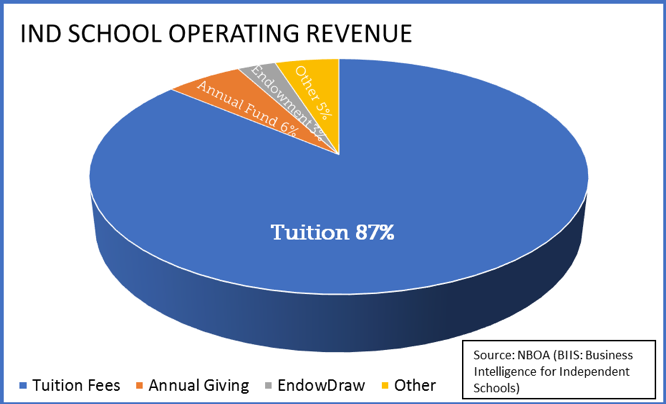In his best-selling book Good to Great, author and researcher Jim Collins says “brutal facts” must be confronted to encourage productive change. He also reminds institutions that they can and will prevail over these facts, if they are disciplined enough to confront reality and build a plan toward improvement. It’s clear that our market is changing and that our community’s reliance on tuition is becoming even more pronounced. It’s also clear that by using every lever available to you from the Enrollment Management Spectrum (below) to integrate your strategies, your school has a strong opportunity to prevail over these new challenges and win new customers by meeting their emerging needs.

Brutal Fact #1: Independent schools are heavily reliant on tuition income to fund operations.
In the graphic below, the National Business Officers Association provides clarity on the independent school community’s growing dependence on tuition. Who in your school ensures the blue section of this pie chart is delivered? In most schools the answer is the admission director. (Note: While teachers contribute to student and family satisfaction, they are not asked to fill empty seats if retention metrics aren’t met. It is critically important that your administrators understand their responsibilities to your school’s bottom line.)

Brutal Fact #2: In most independent schools, enrollment management drivers are not yet well integrated.
Last year, EMA issued What Every Head Needs to Know about Enrollment Management, which illustrates all of the levers that should be used to understand and drive enrollment success. Traditionally, independent schools have focused on only one (recruitment and selection of new students); in 2018, focusing on a single method to meet enrollment targets is perilous!
Don Hossler, senior scholar at USC’s Center for Enrollment Research, Policy and Practice, explains the concept of enrollment management in this way: “It is a system which is informed by research on demographic trends, how parents make enrollment decisions, price sensitivity, and the factors that influence student retention. An inclusive EM approach moves beyond simply hitting an enrollment or budget target to embracing the full journey of a student throughout their time with your school.”
Today’s school leaders must not only work harder to recruit new students, they must also ensure parent and student satisfaction; promote the value of their school brand and educational program; maximize market trends; realize mission through school community composition; set clear tuition, discounting, and financial aid strategies; and see that each student’s journey produces desired and intended outcomes. In most schools, these concerns are being managed and monitored, yet rarely are these areas well integrated, with clear strategy across divisions.
Brutal Fact #3: The customer is changing.
For some time, EMA has heard from school leaders that the “independent school customer is changing.” Our special report 2017 The Ride to Independent Schools makes clear just how much this adage is true! Over 2,700 parents answered our survey, offering feedback about their independent school admission experience. Here’s what they said:
- Our admission process is anxiety producing and too cumbersome (they want schools to work together to streamline systems and they want a “common application”!).
- They want more transparency about what is needed to “get in” (average test scores, average GPA of accepted students).
- Some have trouble perceiving any significant difference between their public school and private school options.
- While parents are driven to consider private schools because of perceived academic rigor, they also want schools that will mold the moral character of their child and care about their child’s social/emotional health.
- Prospective families want more, more, more (time in the classroom, time with an admission officer, information about each school’s unique programs) before they commit tuition dollars.
Suggested Action Steps:
How can you respond to this post?
- Download the reports mentioned in this post (What Every Head Needs to Know about Enrollment Management and 2017 The Ride to Independent Schools). Share these with your leadership team.
- Set aside time to discuss the implications of these reports and the “brutal facts” described in this post for your school. Consider including major stakeholders, such as school board leadership, in the discussion.
- Identify places where your school is addressing these facts, as well as gaps that need attention. Identify three to four “next steps” that you can take at your school to address those gaps.
About the Author
 Heather Hoerle became executive director of SSATB in April 2011. The organization was renamed The Enrollment Management Association in 2016 as a result of the work Heather and the organization’s board of directors did. They transformed the organization from its perception as merely an assessment provider to a membership association created to serve enrollment and admission leaders through the best science, research, and training. A thought leader in enrollment management, Heather commissioned the organization’s first special committee on the future of assessment and personally led the charge for the professionalization of the admission professional, demanding that industry colleagues mobilize to reposition the work of enrollment management as both strategic and foundational to institutional success. Heather’s career began in independent schools as an administrator, student advisor, and teacher at George School (PA) and Westtown School (PA). She then embarked on a successful 23-year tenure in leadership roles with two of the world’s largest nonprofit independent school associations: first as associate director of The Association of Boarding Schools (TABS), then as director of admission and marketing services for The National Association of Independent Schools (NAIS), leading to a vice presidency at NAIS overseeing membership, corporate affiliations, customer service, and the annual NAIS Conference. Heather holds a BA in art history from Mount Holyoke College and an MEd in educational administration from Harvard University.
Heather Hoerle became executive director of SSATB in April 2011. The organization was renamed The Enrollment Management Association in 2016 as a result of the work Heather and the organization’s board of directors did. They transformed the organization from its perception as merely an assessment provider to a membership association created to serve enrollment and admission leaders through the best science, research, and training. A thought leader in enrollment management, Heather commissioned the organization’s first special committee on the future of assessment and personally led the charge for the professionalization of the admission professional, demanding that industry colleagues mobilize to reposition the work of enrollment management as both strategic and foundational to institutional success. Heather’s career began in independent schools as an administrator, student advisor, and teacher at George School (PA) and Westtown School (PA). She then embarked on a successful 23-year tenure in leadership roles with two of the world’s largest nonprofit independent school associations: first as associate director of The Association of Boarding Schools (TABS), then as director of admission and marketing services for The National Association of Independent Schools (NAIS), leading to a vice presidency at NAIS overseeing membership, corporate affiliations, customer service, and the annual NAIS Conference. Heather holds a BA in art history from Mount Holyoke College and an MEd in educational administration from Harvard University.

